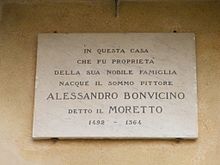- Moretto da Brescia
-
Alessandro Bonvicino (also Buonvicino) (c. 1498 – December 22, 1554), more commonly known as Il Moretto da Brescia, was an Italian Renaissance painter of Brescia and Venice.
 Moretto's family house in Rovato.
Moretto's family house in Rovato.
Contents
Biography
He was born at Rovato, in Brescian territory, and studied first under Fioravante Ferramola. Others state he trained with Vincenzo Foppa. His brothers Pietro and Jacopo were also painters. The 1911 Britannica claims he apprenticed with Titian in Venice and that Moretto modelled his earlier portrait-painting style on the Venetian style. On the other hand, the style also resembles that of Giorgione or late Bellini. The 1911 Britannica also states that he conceived a great enthusiasm for Raphael, though he never traveled to Rome; on the other hand, his classical serenity resembles that shown by Leonardo and his followers in Lombardy such as, for example, Bramantino.[1] He may have consulted with his contemporary Girolamo Savoldo.[2]
Moretto excelled more in sedate altarpieces than in narrative action, and more in oil-painting than in fresco, although he painted fine frescoes depicting the lollygagging daughters of Count Martinengo in one of the palaces near Brescia. In 1521, he worked with Girolamo Romanino in the Cappella del Sacramento in the old cathedral of Brescia, where Moretto completed a Last Supper, Elijah in the Desert, and a Fall of Manna.[3] He was active during 1522-24 in Padua.
He painted alongside with Lorenzo Lotto at Santa Maria Maggiore in Brescia. Also in Brescia, he completed a Five Virgin Martyrs and his masterpiece, the Assumption of the Madonna for the church of San Clemente; a Coronation of the Madonna with four saints (c. 1525) for the church of Santi Nazaro e Celso; a St. Joseph for Santa Maria della Grazie; and a St Nicholas of Ban for Santa Maria de Miracoli. He collaborated with Floriano Ferramola in the decoration of the dome of the cathedral in Brescia.
In the Kunsthistorisches Museum, Vienna is a St Justina (once ascribed to Pordenone); in the Staedel Museum, Frankfort, the Madonna enthroned between Sts Anthony and Sebastian; in the Berlin Museum, a colossal Adoration of the Shepherds, and a large votive picture (one of the master's best) of the "Madonna and Child," with infant angels and other figures above the clouds, and below, amid a rich landscape, two priests; in the National Gallery, London, St Bernardin and other saints and two impressive portraits.
Throughout his career his works display an internal oscillation between the traditions of the Venetian and Central Italian schools. Simultaneously he looked at the form and colour of Venetian artists such as Titian and Palma Vecchio (1480–1528) whilst his classicising, sweet intensity earned him the name 'Raphael of Brescia'. Though there is some uncertainty regarding his studio, he took on a number of pupils the most important of whom was the portraitist Giovanni Battista Moroni (c.1520-1578). Il Moretto is stated to have been a man of great personal piety, preparing himself by prayer and fasting for any great act of sacred art, such as the painting of the Virgin-mother. His dated works extend from 1524 to 1554, and he taught the portrait-painter Giambattista Moroni. He also influenced Callisto Piazza.
Public collections
Moretto is represented in the following collections: National Gallery, London; Metropolitan Museum, New York; Hermitage, St. Petersburg; Kunsthistorisches Museum, Vienna; Staedel Museum, Frankfurt; Gallerie dell'Accademia, Venice; Pinacoteca Tosio Martinengo, Brescia; Pinacoteca Ambrosiana, Milan; National Gallery of Art, Washington; Ashmolean Museum, Oxford; Museum of Fine Arts, Budapest, amongst others.
References
Sources
 This article incorporates text from a publication now in the public domain: Chisholm, Hugh, ed (1911). "Il Moretto". Encyclopædia Britannica (11th ed.). Cambridge University Press. http://www.1911encyclopedia.org/Il_Moretto.
This article incorporates text from a publication now in the public domain: Chisholm, Hugh, ed (1911). "Il Moretto". Encyclopædia Britannica (11th ed.). Cambridge University Press. http://www.1911encyclopedia.org/Il_Moretto.- Freedberg, Sydney J. (1993). Painting in Italy, 1500-1600. Penguin Books. pp. 367–373.
- Federico Nicoli Cristiani (1807). Della Vita delle pitture di Lattanzio Gambara; Memorie Storiche aggiuntevi brevi notizie intorno a' più celebri ed eccelenti pittori Bresciani. Spinelli e Valgiti, Brescia. pp. 139–141. http://books.google.com/books?id=FF0GAAAAQAAJ&pg=PP11&dq=Federico+Nicoli+Cristiani.
Categories:- 1498 births
- 1554 deaths
- People from the Province of Brescia
- Italian painters
- Brescian painters
- Renaissance painters
Wikimedia Foundation. 2010.


